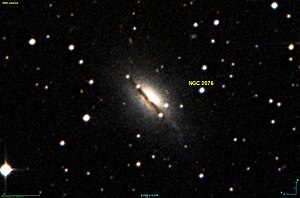NGC 2076
| Galaxy NGC 2076 |
|
|---|---|

|
|
| AladinLite | |
| Constellation | Hare |
|
Position equinox : J2000.0 , epoch : J2000.0 |
|
| Right ascension | 05 h 46 m 47.4 s |
| declination | -16 ° 46 ′ 57 ″ |
| Appearance | |
| Morphological type | S0 +: sp |
| Brightness (visual) | 13.0 likes |
| Brightness (B-band) | 13.9 likes |
| Angular expansion | 2.2 ′ × 1.3 ′ |
| Position angle | 45 ° |
| Surface brightness | 14.0 mag / arcmin² |
| Physical data | |
| Redshift | 0.007145 +/- 0.000017 |
| Radial velocity | 2142 +/- 5 km / s |
|
Stroke distance v rad / H 0 |
(89 ± 6) · 10 6 ly (27.3 ± 1.9) Mpc |
| history | |
| discovery | William Herschel |
| Discovery date | February 4, 1785 |
| Catalog names | |
| NGC 2076 • PGC 17804 • MCG -03-15-012 • IRAS 05445-1648 • 2MASX J05464670-1647083 • SGC 054434-1647.9 • GC 1274 • H III 267 • LDCE 0407 NED008 | |
NGC 2076 is a lenticular galaxy of the Hubble type S0-a in the constellation Rabbit south of the celestial equator . It is estimated to be 89 million light-years away from the Milky Way and has a diameter of around 60,000 ly.
In the same area of the sky is the galaxy NGC 2089 .
The object was discovered by William Herschel on February 4, 1785 .
